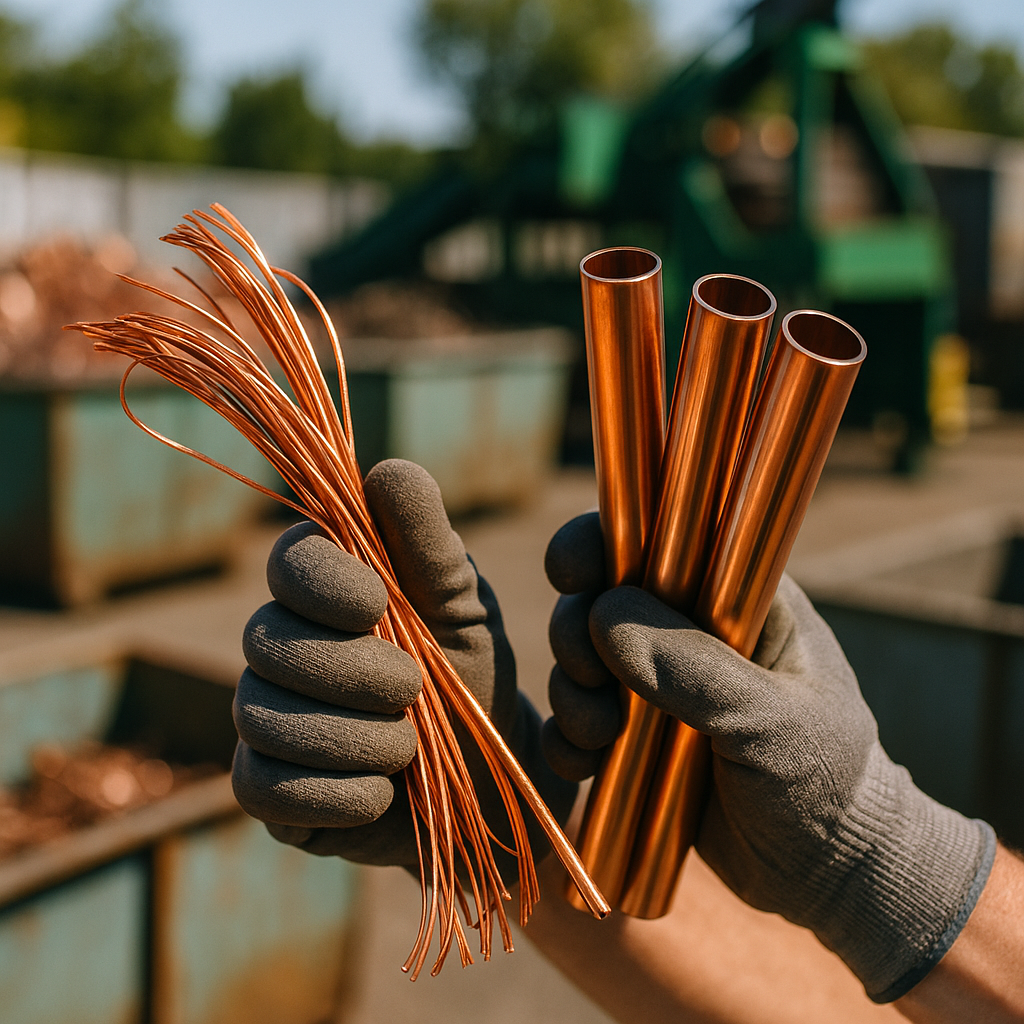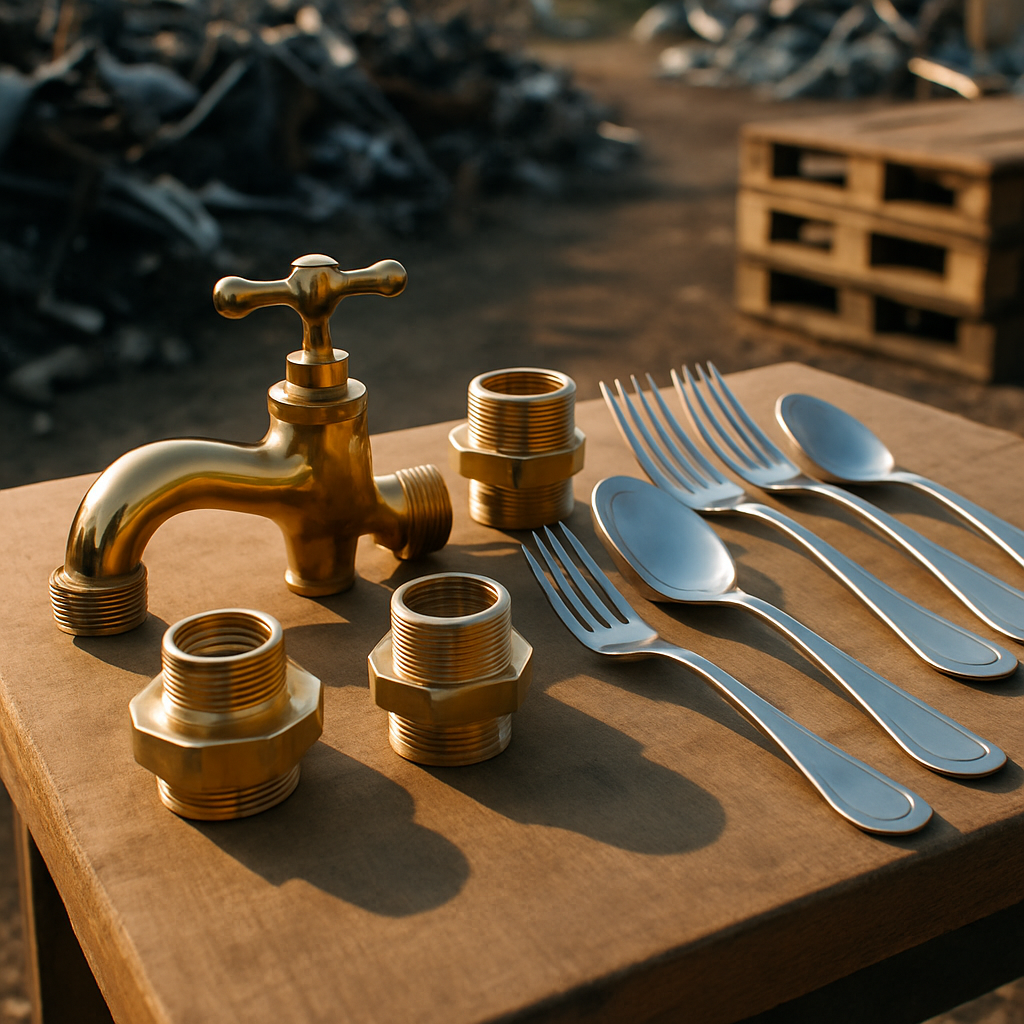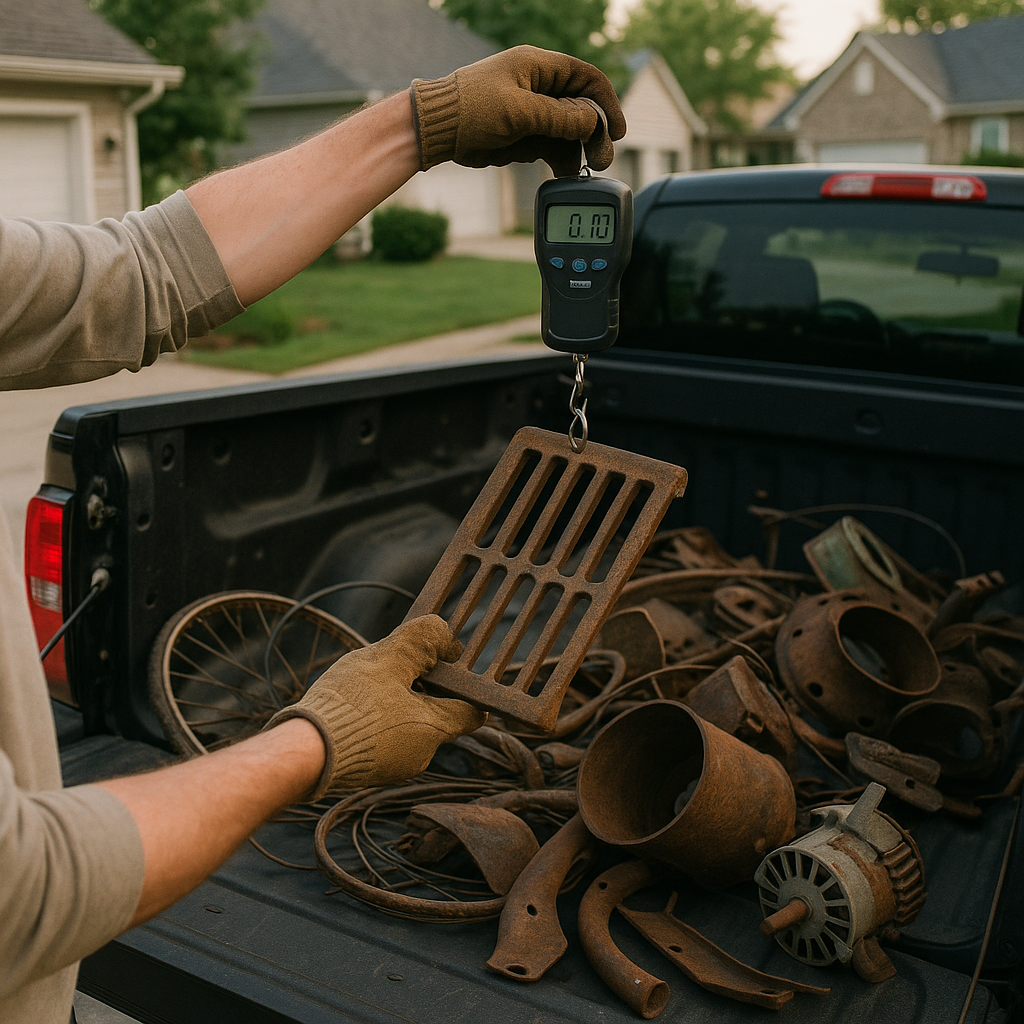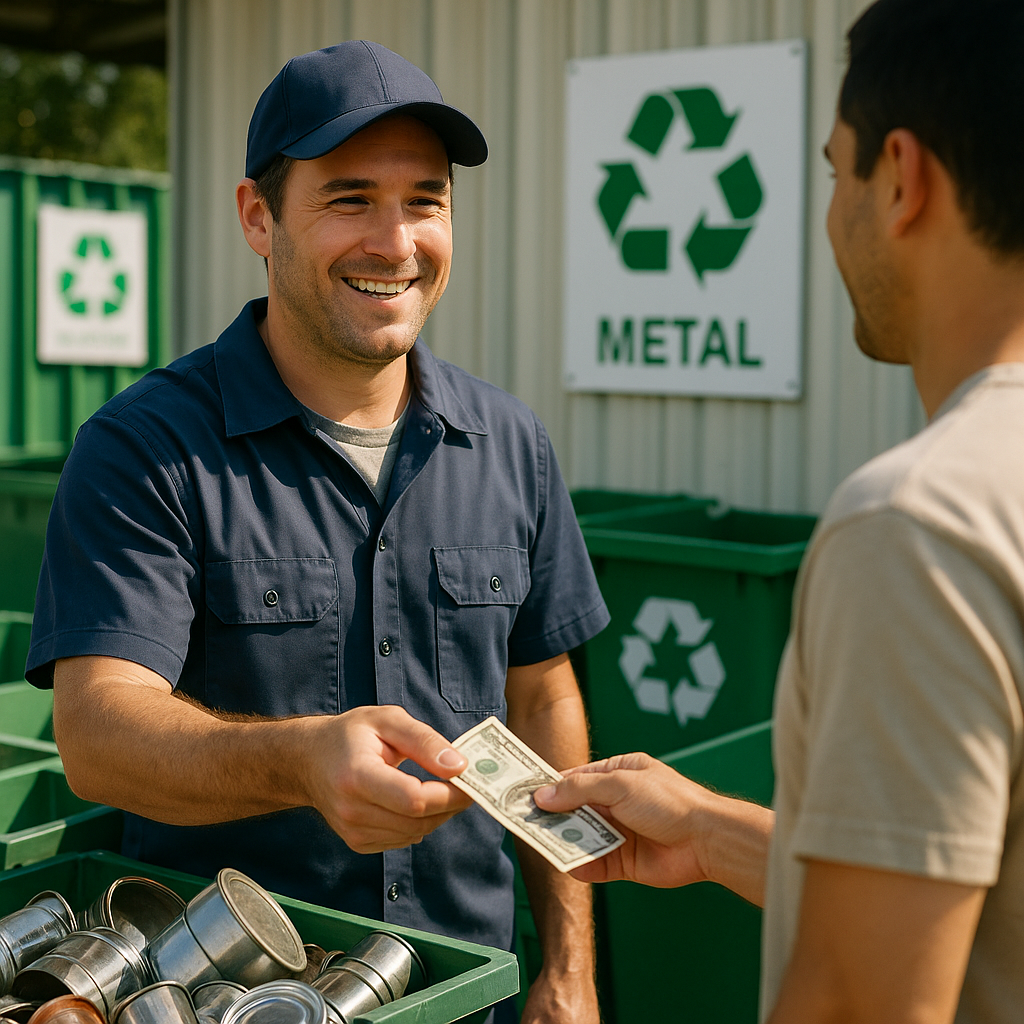5901 Botham Jean Blvd, Dallas, TX 75215
What Are the Most Valuable Scrap Metals to Collect?
September 25, 2025The global scrap metal recycling market is projected to reach $77 billion by 2028, driven by growing demand for sustainable materials and resource conservation. Within this thriving industry, certain metals consistently command premium prices due to their intrinsic properties and industrial applications.
Copper is the most valuable metal in the scrapyard, typically fetching $3-$4 per pound. Its exceptional conductivity makes it indispensable for electrical wiring, plumbing, and electronics. Recycling copper saves 85% of the energy required to produce new copper from ore, which significantly enhances its environmental value beyond its market price.
Brass is the second most valuable common scrap metal, commanding $1.50-$2.50 per pound. This copper-zinc alloy is valued in plumbing fixtures, musical instruments, and decorative hardware. Although aluminum is less valuable per pound at $0.30-$0.90, it is abundant and easily recyclable, providing a steady income source for recyclers. Stainless steel, especially non-magnetic types like 304 and 316 grades, completes the list of commonly available valuable scrap metals.
Why is Copper Considered the Best Scrap Metal to Collect?

Copper is often seen as the top choice in the recycling business due to its high market value, making it a favorite among scrap metals. It frequently leads discussions about profitability among recyclers.
Copper’s value is largely due to its excellent conductivity. Few metals match copper’s ability to efficiently transfer electricity and heat. This trait keeps it in constant demand in diverse industries, from electrical manufacturing to construction.
The metal’s distinctive reddish-brown color makes it easy to identify, even for beginners. Unlike other metals that require testing for confirmation, copper’s appearance is unmistakable.
Exceptional Recyclability
Copper has the rare ability to be recycled repeatedly without losing its properties. This means recycled copper maintains nearly the same value and performance as newly mined material.
The environmental benefits are significant, as recycling copper uses up to 85% less energy compared to new copper ore extraction, significantly reducing carbon emissions and preserving natural resources.
These advantages create a strong market for recycled copper. The demand remains steady, supporting everything from electrical infrastructure to renewable energy technology.
Diverse Grades, Varied Values
Not all copper scrap is equal in value. Understanding grading is crucial for maximizing returns. The highest grade, bare bright copper, is unalloyed, uncoated wire with a minimum 16-gauge thickness.
This pure form commands premium prices, often around $4.00 per pound, due to its purity and minimal processing needs. Its shiny surface is easily recognized by scrap dealers.
#1 copper includes clean pipes and wires with minimal impurities. Slight corrosion or small amounts of solder may be present, but this grade remains valuable, although less so than bare bright copper.
#2 copper has more contaminants like paint or coatings, which require extra processing, reducing its value per pound.
Sourcing Copper Scrap
Copper is commonly found in homes and workplaces. Electrical wiring is a frequent source, especially available during renovations or demolitions.
Older plumbing systems hold significant amounts of copper, offering good scrap value when buildings are updated. Air conditioning units and heat exchangers contain copper coils and tubing that recyclers seek.
Electronics and appliances are also rich copper sources. Motors, transformers, and circuit boards contain recoverable copper parts. Even small amounts can accumulate value.
Computers, especially older ones, may contain copper in wiring and components. Disassembling these can yield valuable scrap.
| Grade | Copper Content (%) | Characteristics |
|---|---|---|
| Bare Bright Copper | 99.9% | Unalloyed, uncoated wire, no oxidation, highest market value |
| No. 1 Copper | 95-99% | Clean, unalloyed wires, slight oxidation permitted, high value |
| No. 2 Copper | 94-96% | Includes coatings/solder, darker color, lower value than No. 1 |
| No. 3 Copper | 88-92% | Contains paint, tar, heavy oxidation; lowest value, requires more processing |
For businesses generating industrial scrap, copper remnants from manufacturing can be a profitable resource. Establishing collection systems for copper offcuts and damaged materials can turn potential waste into revenue.
How Can You Maximize Profits from Aluminum Scrap?

While aluminum doesn’t command the high per-pound prices of copper, its abundance makes it a valuable scrap metal. Aluminum is lightweight, corrosion-resistant, and infinitely recyclable without losing quality. This sustainability factor enhances its value in today’s resource-conscious economy.
Aluminum scrap comes from many sources in our daily environment. Beverage cans are the most recognized form, but substantial quantities are also found in window frames, gutters, siding, automotive components, and electronics. Each source yields different grades of aluminum with varying market values.
Maximizing profits hinges on proper sorting and preparation. Sorting aluminum by type significantly increases its recycling value. Clean extrusions (e.g., window frames, door frames) typically fetch higher prices than cast aluminum (e.g., engine parts) or mixed aluminum. Proper separation prevents cross-contamination, which can reduce the value of the entire batch.
When preparing aluminum scrap, remove all non-metal attachments, such as plastic handles, rubber gaskets, and steel screws. Clean aluminum receives better prices because it requires less processing at recycling facilities. For aluminum cans, a simple rinse removes residue that could contaminate the recycling process.
Organization improves efficiency in your recycling operation. Use dedicated containers for different aluminum types to prevent accidental mixing. This systematic approach eases transportation and ensures accurate pricing when selling your scrap.
Timing your sales strategically can also increase profits. Aluminum prices fluctuate based on market conditions, with spring and summer months often seeing higher prices due to increased construction activity. Monitoring market trends through recycling websites or apps helps identify optimal selling periods.
Beyond financial benefits, recycling aluminum offers significant environmental advantages. The process saves over 90% of the energy required to produce new aluminum from raw materials. This energy conservation translates to reduced carbon emissions and a significantly lower environmental impact.
Building relationships with reputable recycling centers offers long-term benefits. Regular customers often receive priority service and may qualify for better pricing. Research local facilities to find those offering competitive rates specifically for aluminum.
For large-volume recyclers, consider investing in basic processing equipment. Simple tools like can crushers reduce storage space requirements and make transportation more efficient. Wire strippers can help remove valuable copper wiring from aluminum components in electronics.
The quality of your preparation directly impacts your profitability. Take time to identify different aluminum grades correctly using visual inspection and simple tests. Pure aluminum has a silvery-white appearance and is notably lightweight. When struck, it produces a dull sound rather than the ring of steel.
| Aluminum Scrap Type | Characteristics | ISRI Code |
|---|---|---|
| Aluminum Wire Scrap | Shiny, silvery appearance; 99% Aluminum content | TALON, TASSEL |
| Aluminum Extrusion Scrap | Clean, unalloyed; 97% to 99% Aluminum content; includes 6063 (TATA), 6061/7075 (TUTU) forms | TATA, TUTU |
| Aluminum Sheet Scrap | Unalloyed thin gauged; includes gutters, wall roofing/panels | TAINT, TALE |
| Aluminum UBC Scrap | Commonly found in beverage cans | TALC |
| Aluminum Turnings and Borings | Produced during processing with 97% to 99% Aluminum content | TEENS, TELIC |
What Makes Brass and Stainless Steel Valuable Scrap Metals?

Brass is highly valued in the scrap metal market due to its unique composition. This copper-zinc alloy is easily identified by its distinctive golden appearance and weight. The value of brass scrap is directly linked to its copper content, which typically ranges from 60-90% depending on the specific alloy. Common sources of brass scrap are plumbing fixtures, musical instruments, and decorative items.
Brass is prized in the recycling industry for several reasons. Its lower melting point compared to many metals results in reduced energy consumption during recycling. The metal retains its properties when recycled, making it suitable for continuous reuse. Brass scrap with minimal contaminants will always command premium prices at recycling facilities.
Stainless steel offers a different value proposition in the scrap market. Although it generally commands a lower price per pound than brass, its extensive use in appliances, construction materials, and industrial equipment makes it widely available. The metal’s worth depends significantly on its grade, which indicates the specific alloy composition.
The value of stainless steel is primarily determined by its chromium and nickel content. These components make it resistant to corrosion and staining. Higher-grade stainless steel, such as 304 and 316, which contain higher levels of nickel, fetch better prices than lower grades. Recyclers often use a magnet test to evaluate high-value stainless steel, as many premium grades are non-magnetic.
Both metals play a significant role in sustainable manufacturing practices. Recycled brass and stainless steel help reduce the need for raw material extraction, decreasing environmental impact while preserving valuable resources. Manufacturing industries consistently seek these recycled materials to lower production costs and achieve sustainability goals.
Proper identification is crucial for maximizing scrap value. Brass usually has a warm golden color that darkens with age, while stainless steel is bright, reflective, and smooth. A weight test is also useful—brass feels considerably heavier than similarly sized pieces of aluminum or regular steel. For stainless steel, checking for magnetic properties can help determine its grade and potential value.
Demand for these metals remains strong across construction, automotive, and manufacturing sectors. Their resilience, aesthetic appeal, and functional properties ensure they retain value even during market fluctuations. Savvy recyclers who accurately identify, clean, and sort these metals can maximize their returns in the scrap market.
| Property | Brass | Stainless Steel |
|---|---|---|
| Composition | Copper-Zinc Alloy | Iron-Chromium Alloy, contains Nickel |
| Brinell Hardness | 55-73 | 146-595 |
| Tensile Strength (MPa) | 340-470 | 500-1100 |
| Corrosion Resistance | Good, but degrades in saltwater | Excellent, forms protective chromium oxide layer |
| Thermal Conductivity (W/m·K) | 109 | 16 |
| Electrical Conductivity | High | Low |
| Recyclability | High | High |
Processing requirements vary for these metals. Brass benefits significantly from basic cleaning and removal of non-metal attachments before recycling. For stainless steel, separating it from regular steel and identifying specific grades significantly increases its value. To achieve optimal prices at recycling facilities, both metals should be free from excessive oil, grease, or contaminants.
How to Get Started Collecting and Selling Scrap Metal

Entering the scrap metal recycling business doesn’t require a large capital investment or specialized education. With some basic knowledge and essential tools, you can divert valuable materials from landfills while earning income. The key is knowing what to collect and how to maximize the value of your finds.
Research Local Scrap Yards
Before collecting any metal, research the scrap yards in your area. Prices, accepted materials, and minimum quantity requirements can vary significantly between facilities. Call to compare current rates, operating hours, and payment methods. Some yards pay cash on the spot, while others issue checks or require bank accounts for electronic transfers.
Visit potential yards in person to observe their operations. Pay attention to how they weigh materials, their sorting requirements, and how they treat small-scale collectors. A reputable yard clearly displays pricing and follows transparent weighing practices. Building a relationship with a consistent buyer for your scrap often leads to better prices over time.
Essential Tools for Scrapping
Success in scrap metal collection hinges on having the right tools. Start with these basics:
- Magnet: Use a strong magnet to distinguish ferrous metals (iron-containing) from non-ferrous metals. Non-ferrous metals like copper, aluminum, and brass don’t stick to magnets and usually fetch higher prices.
- Sorting Containers: Dedicated bins or buckets for different metal types help prevent mixing, significantly boosting your payout. Avoid combining high-value metals with lower-value ones.
- Small Scale: A digital scale helps estimate the value of your finds before heading to the yard, preventing surprises and aiding in inventory tracking.
- Basic Hand Tools: Wire cutters, pliers, screwdrivers, and wrenches assist in disassembling items to separate different metal components.
- Safety Gear: Heavy-duty gloves, safety glasses, and cut-resistant clothing protect against sharp edges and potential hazards.
- Transportation: A pickup truck, trailer, or even a car with folding seats can haul your scrap to recycling centers.
Focus on High-Value Materials
Not all scrap metal offers equal returns. For beginners, focusing on easy-to-identify, high-value materials can be efficient:
Copper wiring from discarded electronics, appliances, or construction waste often provides the highest return per pound. Brass plumbing fixtures like valves, faucets, and pipe fittings contain valuable copper and zinc alloys. Aluminum cans, gutters, siding, and window frames are lightweight and readily available in residential settings.
While steel and iron fetch lower prices per pound, their abundance makes them worth collecting, especially if you have access to large quantities from construction sites or equipment disposal.
Proper Sorting and Preparation
Proper preparation greatly impacts your scrap metal returns. Always sort metals before arriving at the scrap yard. Remove non-metal attachments like plastic, wood, or rubber as they reduce value. Clean your scrap of dirt, grease, and other contaminants using simple tools like wire brushes.
For copper wire, specifically, stripping the plastic insulation significantly increases its value, though this requires weighing the time investment against the potential return. Some recyclers accept motors and electrical components as separate categories with specific pricing, so ask before disassembling these items.
Building Sustainable Supply Sources
Consistent scrap metal income requires reliable material sources. Build relationships with local businesses that generate metal waste regularly. Construction companies, contractors, plumbers, electricians, and HVAC services all produce valuable scrap. Offer to collect their metal waste for free, saving them disposal costs.
Check with local businesses like restaurants, offices, and retail stores discarding metal fixtures during renovations. Community cleanup events also provide opportunities to collect discarded appliances and other metal items. Always obtain permission before taking materials from any location.
Understanding Local Regulations
Scrap metal collection and sales are increasingly regulated due to theft concerns. Many jurisdictions require identification when selling certain metals, particularly copper. Some areas impose waiting periods for payment on specific materials or require detailed documentation about material sources.
Certain items like catalytic converters often have special requirements, including proof of ownership or vehicle documentation. Some materials may be restricted altogether due to environmental or safety concerns. Check with local authorities about regulations before starting your collection efforts to ensure compliance with all requirements.
By focusing on these fundamentals, you can establish a profitable scrap metal collection operation that contributes to recycling efforts while generating income. The industry rewards knowledge, preparation, and building relationships with both suppliers and buyers.
| Metal | Common Uses | Identification Characteristics | Magnetic |
|---|---|---|---|
| Copper | Plumbing, electrical wiring, roofing | Fiery red-orange with hints of browns; malleable | No |
| Aluminum | Cans, siding, car parts | Silvery-white with a matte finish; lightweight | No |
| Brass | Plumbing fixtures, musical instruments, decorative items | Yellow-brown, golden color; quite hard | No |
| Steel | Appliances, construction materials, vehicles | Silvery, shiny finish; rougher texture | Yes |
| Lead | Batteries, old water pipes | Very heavy; a dull grey color | No |
| Iron | Radiators, gates, railings | Forms reddish-brown rust | Yes |
Conclusion: Turning Scrap into Profit Sustainably

Collecting and selling scrap metal offers a unique opportunity where financial gain aligns perfectly with environmental stewardship. By concentrating collection efforts on high-value metals like copper, aluminum, brass, and stainless steel, recyclers can maximize returns while supporting sustainable resource management. Proper sorting, cleaning, and preparation of scrap materials can significantly increase profits, often boosting values by 15-40% compared to mixed or contaminated loads.
The scrap metal industry exemplifies how environmental responsibility can drive economic prosperity. With a solid understanding of material identification, market timing, and buyer relationships, what many perceive as waste transforms into a valuable commodity. For your recycling needs, contact Okon Recycling at 214-717-4083.
